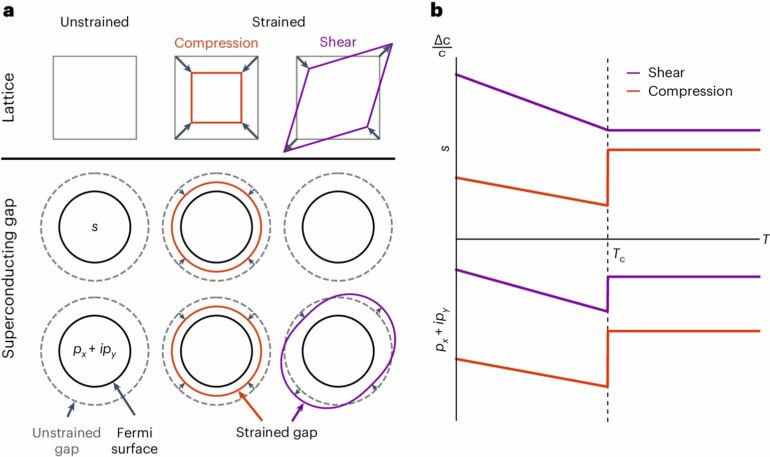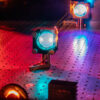With pulses of sound through tiny speakers, Cornell physics researchers have clarified the basic nature of a new superconductor.
Since it was found to be a superconductor about five years ago, uranium ditelluride has created a lot of buzz in the quantum materials community—and a lot of confusion, with more than a dozen theories about the true nature of its superconducting properties. Some suggested valuable possibilities for quantum computing.
In an experiment, Brad Ramshaw, associate professor of physics in the College of Arts and Sciences (A&S) and colleagues have used ultrasound to gather direct evidence that uranium ditelluride has a single-component superconducting order parameter, ruling out a more exotic type of superconductor that would have been exciting news for quantum computing. But setting a baseline of data for the material’s intrinsic superconductivity still leaves the door open for discovering additional complex possibilities through further study.
The experiment establishes that recent technical developments in the Ramshaw lab make pulse-echo ultrasound, which uses sound pulses to examine the mechanical stiffness of quantum materials, a trustworthy and desirable technique for examining superconducting materials.
The research report, titled “Single-component Superconductivity in UTe2 at Ambient Pressure,” is published in Nature Physics. Ramshaw is corresponding author with doctoral student Florian Theuss as first author. Doctoral student Avi Shragai and former postdoctoral researcher Gael Grissonnanche, now faculty at the Institut Polytechnique in Paris, contributed, along with collaborators from the University of Maryland and the University of Wisconsin, Milwaukee.
“All superconductors have zero resistance, but at a subtler level, there are different flavors of superconductors,” Ramshaw said. “Researchers are interested in finding these different flavors because, one, we don’t even know if they exist, even though we know in theory that they can exist. And two, they can be used in technologies like quantum computation. You need new types of superconductors for new technologies.”
A strange combination of properties in uranium ditelluride suggested at first that it could be this new type of superconductor. Its critical temperature—how cold it has to get before transitioning into a superconducting state—is relatively low, about 2 Kelvin. But its low critical temperature is paired with a very high critical field—the measure of how much magnetic field it can withstand before the superconducting state collapses.
“We would normally expect it to withstand one or two tesla, but it can withstand around 60,” Ramshaw said. “It is nearly 100 times stronger than any magnetic field you’d encounter in everyday life. That tells us there’s something weird, that maybe it’s one of those new flavors of superconductivity.”
Ramshaw and his collaborators wanted to find whether the material has—as some theories and existing experiments had predicted—a multi-component superconducting order parameter, entailing exotic effects; or single-component order parameter, still potentially exotic but much more constrained.
Theuss led an experiment using pulse-echo ultrasound on a 1-millimeter by 1-millimeter sample to uncover the interplay between the structure and superconductivity in uranium ditelluride. The technique measures the speed of a sound pulse moving through a material, the same principle as medical ultrasound imaging. The difference is that instead of producing images, the researchers measured the sound speed to detect the change in stiffness of the material as it cooled down to and past the critical temperature.
“We can measure the distance between the sound echoes with phenomenal precision. That’s the real power of the experiment,” Ramshaw said.
Tiny speakers (transducers) attached to the sample pumped a sound pulse directly into the material in three different directions, measuring both three compression waves and three shear waves—the side-to-side vibrations only present in solids.
At the critical temperature, compression waves showed a sudden drop where the speed of sound plummeted, as expected for all superconductors. However, shear waves showed no such drop.
“If it was one of the exotics types of superconductivity people were proposing, these shear waves would have also had a drop,” Ramshaw said.
The researchers provide direct evidence that this material has a single-component order parameter. This conclusion, however, does not quell the excitement about superconductivity in uranium ditelluride, which has many interesting aspects worth further study, including its extraordinarily strong repulsion to magnetism.
Applying pressure or magnetic fields below the critical temperature could change the type of superconductivity, perhaps even creating the elusive two-component spin-triplet superconductivity, Ramshaw said. The current study provides a data-based place to begin.
“Definitely there’s more to come in this material. We’ve only just started,” said Theuss, who has worked with uranium ditelluride for much of his Ph.D. candidacy. “But if you want to explain these complicated things, you have to start at the basic intrinsic facts of the superconductivity in UTe2.”
More information:
Florian Theuss et al, Single-component superconductivity in UTe2 at ambient pressure, Nature Physics (2024). DOI: 10.1038/s41567-024-02493-1
Provided by
Cornell University
Citation:
Ultrasound experiment identifies new superconductor (2024, May 9)



